What Are Safe Kiteboarding Conditions - Chasing the Dream: Ep 03
We've all been there. You've just learned how to kiteboard or you are in the research phase. You find yourself asking a lot of questions. How much wind is too much? What are the safe wind directions? Is it too cold to go kiteboarding? What size kite do I need for my weight? There really is a lot to take in. Fear not, this episode I break down almost everything you need to know about kiteboarding riding conditions.
Last week I was working in San Fransisco and I payed a visit to Crissy field. This is hands down one of my favorite cities as well as kiteboarding locations. That said, it really got me thinking about kiteboarding and safety. Chrissy field is one of the most beautiful places you can kite but it can also be quite dangerous for the inexperienced.
An iconic view yet, known for cold waters, heavy boat traffic, strong currents, and at times off shore wind conditions. It takes a fair amount of time and experience before you would want to kite here. So what kind of conditions should newer riders look out for? So lets talk kiteboarding riding conditions and how you can determine if today is a great day to ride.
How much wind do I need to kiteboard?
The average rider will need about a minimum of 12 miles per hour or 10 knots to ride. This will of course vary greatly depending on kite size and rider weight. You can check out this great wind chart here to help you decide what kite size is right for you. If you are heavier or happen to live in a light wind location there are specialty pieces of gear like light wind kites, light wind boards or foil boards to get you out in extremely light wind.
When is it too windy to go kiteboarding?
This answer varies. if you are an experienced or pro rider you maybe able to go out in 40 miles per hour on small kites. For your average kiteboarder or beginner you might find yourself in a dangerous position around the 35 mile per hour range. We advise new kiteboarders to start small, say in the 15 to 21 miles per hour range. If you're an american just remember the limit while learning is the same as the drinking age and you will never forget! Of course as your skills grow you will be able to ride in more wind as well as less wind. Especially if you have a larger kite and a smaller kite in your quiver. The key is to make sure you are choosing the right size kite for the wind conditions.
Did you know that wind power increase exponentially. When you think about that, 25 mph of wind blows twice as hard as 17 mph. So be conscious in high winds because things can escalate quickly. You know, even I have days where I question if it's too windy to ride. How I decide is by asking myself some questions. Do I have the right gear for these conditions? If something goes wrong do I have a plan and can I handle it? How do I feel as I am pumping my kite? Am I starting to panic a little? Or perhaps I'm already riding and I feel like It's just too much. In those cases, I usually call it a day.
You need to consider the wind direction.
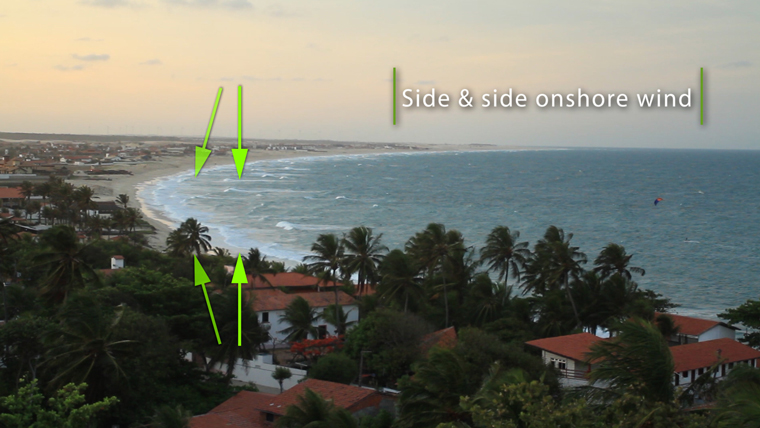
You should aim to ride in only side and side onshore wind conditions. This means that the wind is blowing parallel to the shore or parallel and slightly onto it. In the event of an emergency your kite will pull you back to land. These will also be the smoothest winds. In the image above, the wind coming from the top would technically be smother than the wind coming from the bottom. The reason for this is the trees and buildings in the image would cause a bit of turbulence.
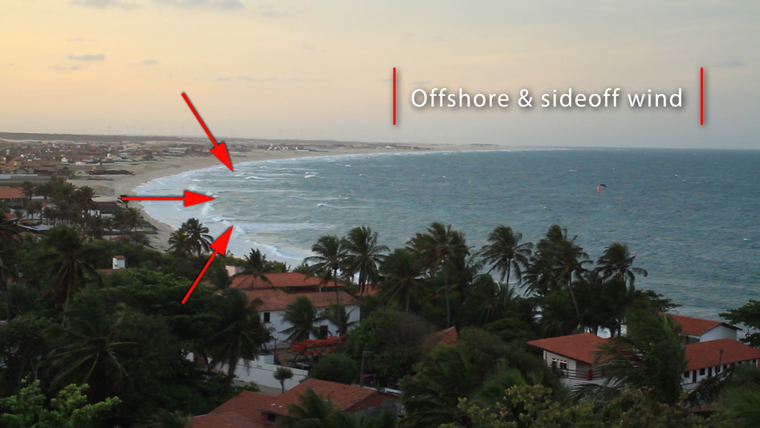
If you decide to ride in off shore conditions... Well, unless you have a rescue boat, it was nice knowing you. Winds blowing even slightly away winds will not only be turbulent and inconsistent but they tend to blow you out to sea if something goes wrong. It's best to pack it up and head home in these conditions.
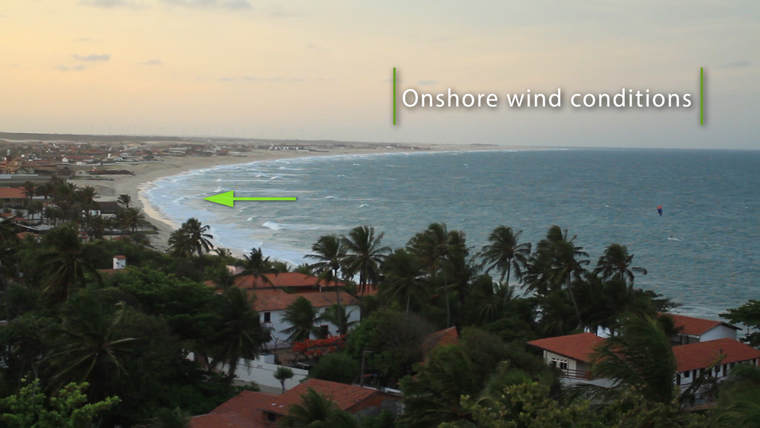
Onshore winds are doable and can be quite fun if you can ride upwind consistently. You do need to be cognizant of obstacles like people and trees on the shore as these winds will want to push your directly back to the beach.
Wind quality is an important factor.
Wind can vary from day to day. You want to aim to ride in smooth and consistent winds. These will be the easiest days for beginners to progress. Avoid strong and gusty winds until you are an experienced rider as these will tend to toss you around and can be quite frustrating. In places where the wind is cold like snow kite locations or perhaps in the spring and the fall, the air is more dense. This means that you will be able to ride the same size kite in less winds. The longer you ride the more you will get a feel for the different wind conditions but for now aim to progress in smooth wind and have a lot of patience on the gustier days.
What about waves?
If your just starting out, avoid waves for now. A heavy shore break can be difficult to navigate. Once you have some experience waves can be incredibly fun. In fact, for some it's the reason they started kiteboarding in the first place.
Weather you are using them as kickers like a wakeboarder or charging down the line on a surfboard. Waves bring a whole new dimension to kiteboarding. Just be mindful of the conditions and speak with a local. Some waves can be more powerful than they appear.
Conditions you should avoid
Aside from the obvious like tornadoes, plagues of locusts, lighting and so on. It's important to keep an eye out for storm systems. Usually, these are preceded by black clouds on the horizon. If you do see a system coming in get of the water fast. On the water storms can move incredibly fast. Usually the wind will pick up and get very strong followed by rain. Then the wind will simply shut off leaving you stranded with a long swim ahead of you.
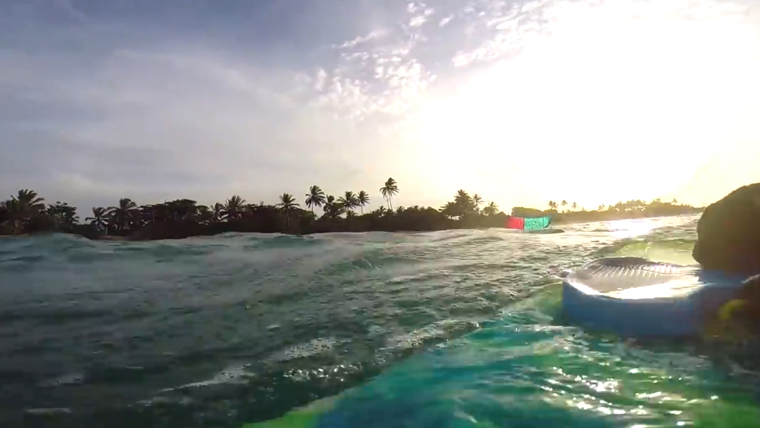
Nothing like a long swim back to the shore.
Aside from hazardous weather, you should avoid busy beaches. As a kiteboarder it is your responsibility to watch out, not only for your own safety but those around you. We are part of a kiteboarding community and it is each one of our jobs to make sure we are operating safely. If an accident happens on a beach, you can almost guaranty that kiteboarding will be banned there. Be careful, take responsibility for your self and the space around you. It's up to use to be safe, welcoming and respectful. We want to keep those beaches open for years to come.
Water temps.
You need to be conscious of water temperature as well. They say you should rest for the swim back not for riding.
In places where the water is under 60 degrees F your body can start showing signs of hypothermia in under 20 minutes. If you have a bad crash or gear malfunction you may not realize that you are in trouble until it's been 10 or 15 minutes of struggling to getting your kite out of the water to no avail. Worse yet, you still have a 20 minute swim ahead of you. If you are riding in cold water or unpredictable riding conditions make sure you have a proper wetsuit and always ride with a friend.
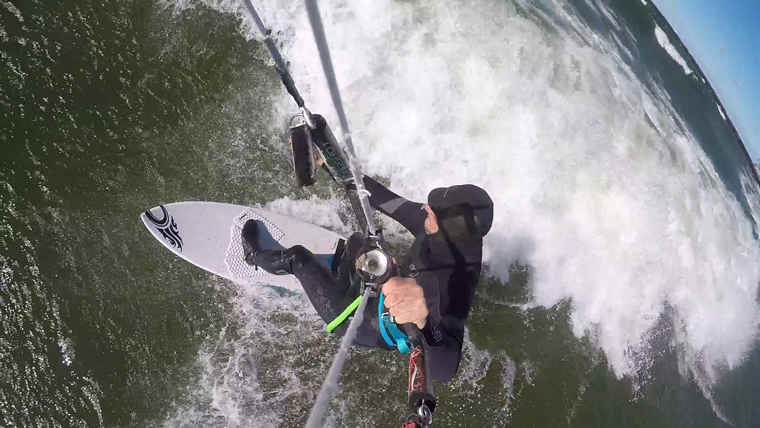
A good wet suit goes a long way
How many days of a year are rideable
This also depends on where you live and if you are willing to travel. Places like the Outer Banks in North Carolina can get up to 250 days a year of good riding conditions. Most people who live near the water can expect to get around any where from 30 to 100 days a year in. A lot of that depends on your schedule, flexibility and what you are willing to drop for the sake of good wind. There are a few ways to make sure that you get more days on the water. One is to make sure you have a solid quiver of gear. The other is to pay attention to the weather forecast and plan your schedule around it. One great resource is Ikitesurf.com Using a tool like this can be indispensable when scoring your next session.
The best thing about kiteboaridng is the more time you spend on the water, the more fun it gets! That about wraps it up for this week. If you have any other questions about gear, weather, riding conditions. Literally anything kiteboarding don't hessiate to ask in the comment section of my video or give MACkite a call. 800 622 4655
 Crystal Veness
Crystal Veness
Originally from Canada, she now calls the entire world her playground and simultaneously her workplace. Whether that's an impromptu office in the back of a rental car on top of a mountain or a hut on kite beach Cabarete, she is a true embodiment of the work-life balance movement.
Website: CrystalVeness.com
Instagram: @crystalintl
Facebook: CrystalVeness
Twitter: crystalintl
Recent Posts
-
Kiteboarding | Crafting the Harlem Force Kite with Sustainability and Performance
Unparalleled Performance Meets Unmatched Sustainability The kiteboarding industry is on …24th Apr 2024 -
Duotone Ventis 2025 | What's New?
If you're familiar with Duotone's Ventis, you know its specialty is freeriding in light wind …23rd Apr 2024 -
Duotone Ventis D/LAB 2025 Overview
If you ride in an area with multiple light wind days and need a wing that'll let you get o …23rd Apr 2024




